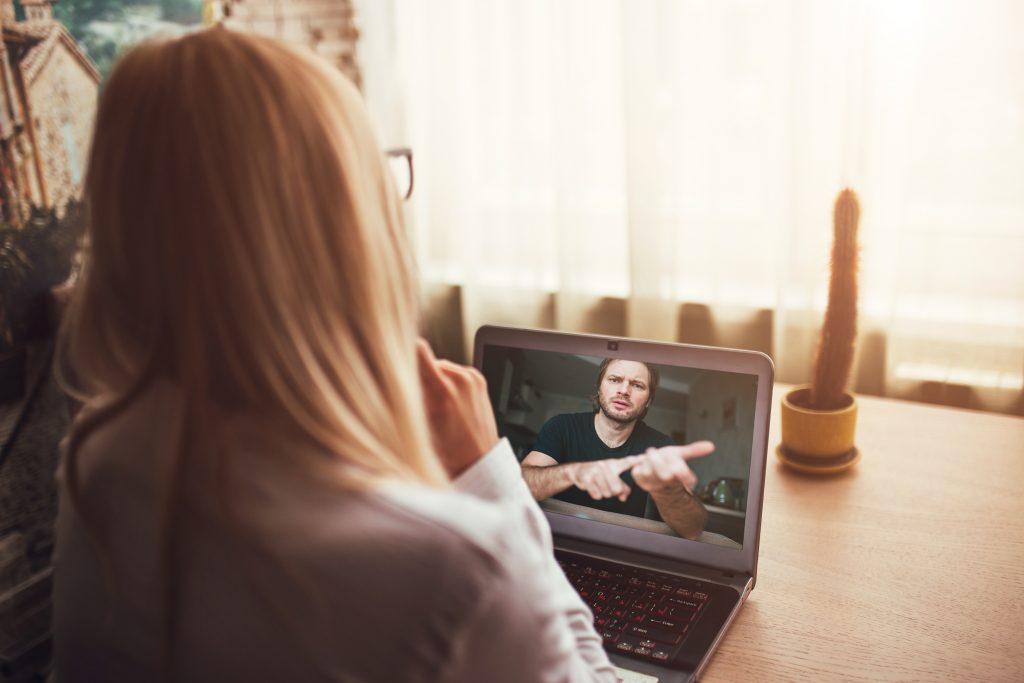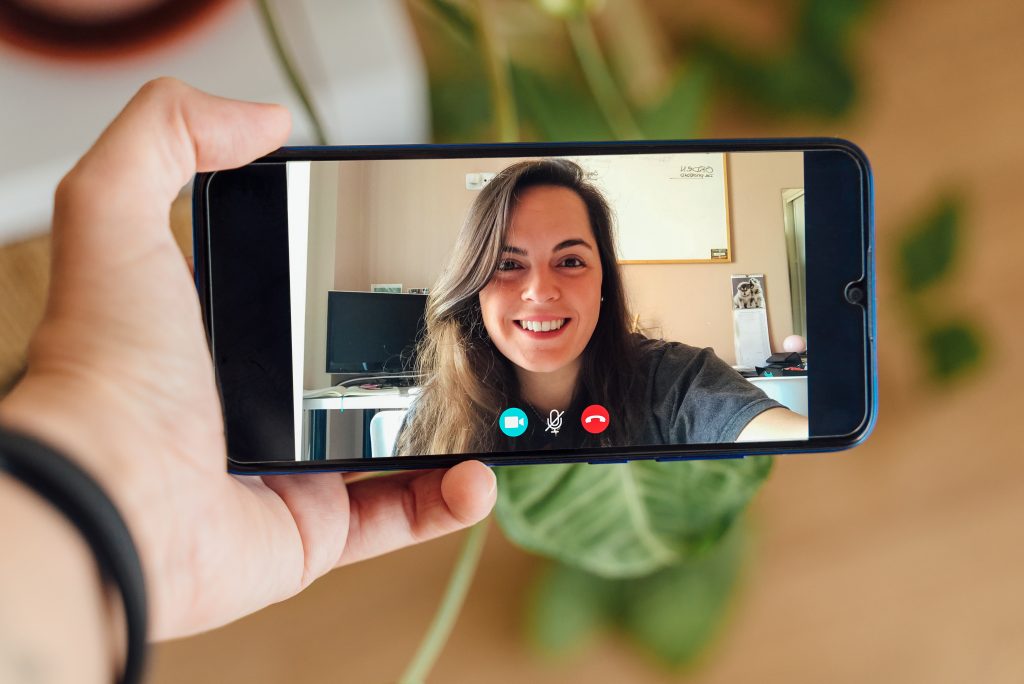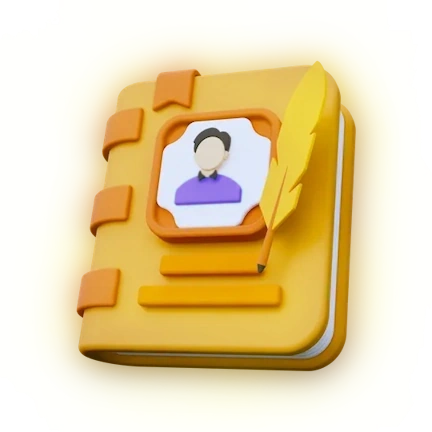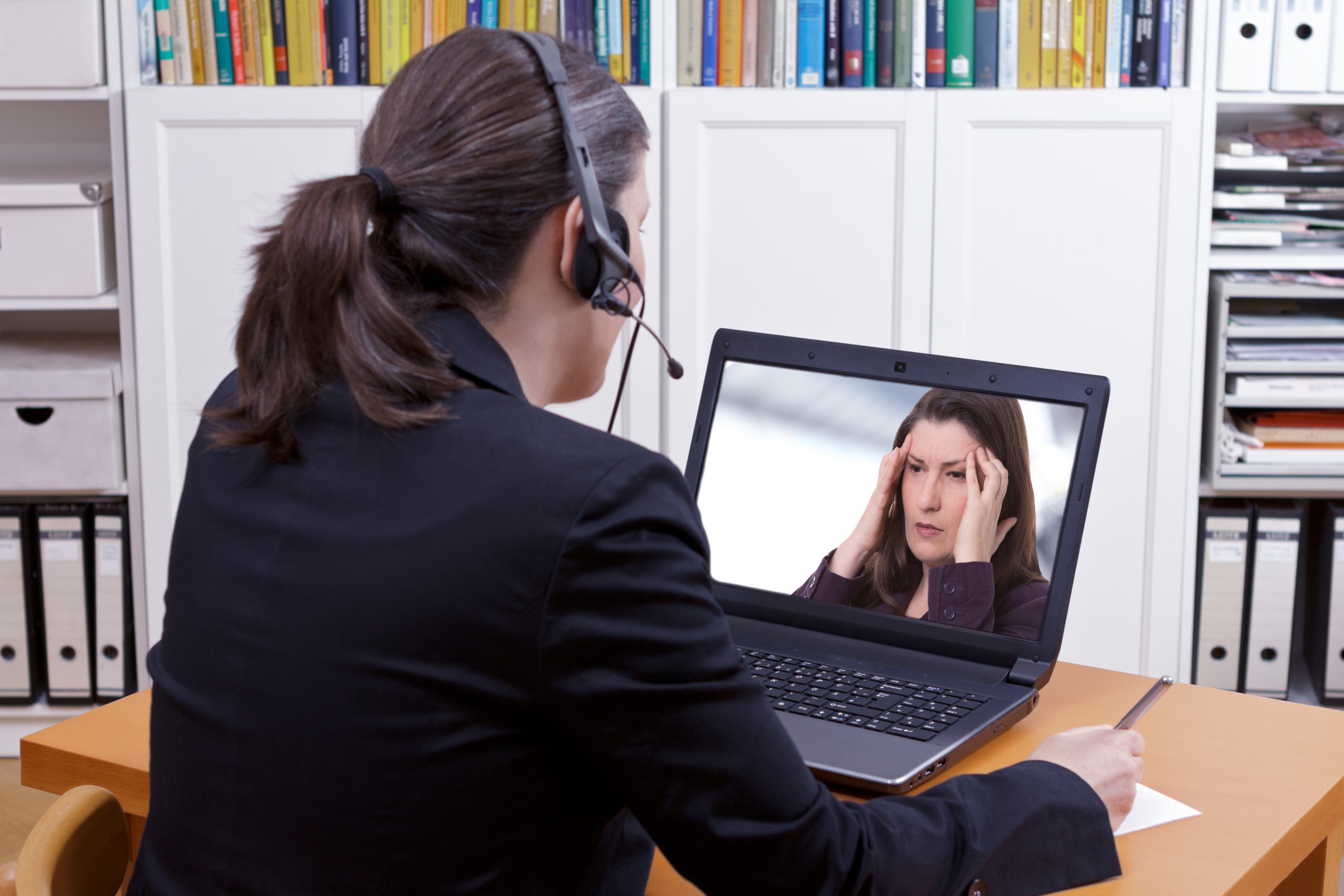LISTEN TO THIS ARTICLE:
Uncertain times, uncertain minds
Since the beginning of the global coronavirus pandemic, mental health needs have skyrocketed, so providers have turned to remote therapy. Almost half of Americans surveyed reported that the pandemic was affecting their mental well-being. One in five said the effect was severe. In April 2020, calls to a national crisis hotline run by the Substance Abuse and Mental Health Services Administration (SAMHSA) increased tenfold over past years. Even if you manage to escape infection by the virus, there are mental health effects of living through a pandemic.
Prescriptions for anxiety, sleep, and depression medications rose, and increased alcohol and marijuana sales suggest people might be self-medicating more.
Threats of disease and death, high unemployment, a divided political climate, and social unrest have made 2020 a year of unparalleled mental anguish in America.
Mental health experts had hoped the initial spike would be temporary. Instead, several months into the pandemic, a major survey by the Centers for Disease Control and Prevention (CDC) showed the situation only getting worse. More than one in ten Americans seriously considered suicide in June 2020, double the rate compared to past years.

The outlook was even bleaker for America’s youth. One in four people aged 18 to 25 having reported contemplating taking their own lives. That’s about 8 million young people who considered death as an escape.
Other at-risk populations are also hurting badly. Hispanics, Blacks, and essential workers have struggled with suicidal thoughts (about 19%, 15%, and 22%, respectively). It seems this pandemic just won’t let up, and it can have devastating effects on the most vulnerable among us.
Therapist, Can You Hear Me Now?
As a result, the demand for mental health services is soaring. Combined with the need for social distancing, this has accelerated the rise of internet-based remote therapy in place of traditional, in-person treatment. This sudden shift to the digital world raises many questions. Is anything in the therapist-client relationship lost when a computer screen replaces the consultation room? Can something as human and intimate as psychotherapy be effective when performed via a two-dimensional, grainy, digital transmission? Let’s explore the pros and cons of “virtual therapy.”
Until now, most professionals and their clients have been slow to adopt virtual mental health services. Before the pandemic, with few exceptions, people preferred in-person therapy. But virtual treatment can offer certain benefits over in-person treatment. In some situations, even before the need for social distancing, remote treatment has helped people overcome barriers that would otherwise have prevented them from accessing treatment
The very problem someone is trying to get help with can itself make it harder to get that support.
The Long Way Home
Small towns and rural areas create one of the most common barriers to accessing care since they often have few mental health professionals. Small towns generally don’t have enough demand to support a therapist, so just a handful will be spread out over entire counties, forcing people to drive long distances for sessions. Rural areas usually lack public transit, making these treks even more difficult if people don’t have easy access to a car.
The shortage of providers in these areas can also make it hard for people to find a therapist who speaks their preferred language or specializes in the type of treatment they need. What’s more, the social stigma around therapy can have a more substantial effect.
Home is Where the Safety Is
It is perhaps a cruel irony that the very problem someone is trying to get help for can itself make it harder to get that support. For example, people who struggle with severe depression may find it challenging to get out of bed and get dressed, let alone drive an hour for therapy. Symptoms may paralyze those with panic, anxiety, or agoraphobia so that they cannot leave their homes. A person recovering from a substance use disorder may have a suspended driver’s license and be unable to get to a provider’s office.
Even if you can get out of the house, for some, just driving on busy roads or sitting in a waiting room can be filled with emotional strife. Then there is the privacy issue. Most consider psychotherapy to be a private endeavor, and news travels fast in small communities. Remote therapy makes it possible to have your sessions in the privacy of your home, no travel necessary.
The costs of travel include gas, parking, tolls, or tickets for public transit. Even worse, since none of these costs are on a sliding scale based on income, access to therapy gets … more expensive the poorer you are.
We’re in This Together – Virtually
Kim Kelsey, LCSW, psychotherapist in York, Maine, believes that remote therapy for couples and families permits the parties to be brought together virtually while also feeling safe. “One of the advantages is people want to be in their own space when they [use telehealth],” says Kelsey. In these cases, she believes that video calls provide therapy options where there was none before.

It’s about time
Remote therapy can also be more economical. The costs of travel include gas, parking, tolls, or tickets for public transit. Even worse, since none of these costs are on a sliding scale based on income, access to therapy gets relatively more expensive the poorer you are. When you are living paycheck to paycheck, every dollar counts.
Remote therapy saves time, too. The time that would have been spent traveling to and from a therapist’s office can be freed up for work, family, or other activities.
Cost saving
Working remotely can lower costs for therapists as well. A therapist who sees all of their clients remotely does not need to rent office space, cutting out one of their most significant overhead expenses.
Late cancellations and no-shows can mean lost time and income for therapists. But, according to Kelsey, remote therapy offers a workaround. For instance, if the weather is bad or a client has to be home with their children, they very likely can still attend a session using telehealth. Constance Hanley, PhD, clinical psychologist, agrees, remarking that with telehealth, “the no-show rate is near zero.”
We are running a giant experiment. Although some studies – and companies marketing these remote services – tell a rosy story, there are a few more stories to tell.
Remote therapy is convenient and flexible. It lets people work outside normal business hours. If you’re ready to talk early in the morning or later in the evening, teletherapy allows that. By embracing people’s natural circadian rhythms, remote sessions can potentially lead to more effective therapy.
So, it’s all good, right? Not so fast
According to the American Telemedicine Association, telemental health is equally as effective as in-person therapy for many populations. People with dementia, depression, PTSD, ADHD, substance use, and anxiety all benefit. This holds across a wide range of age groups, from young children to older adults. Many children and young adults prefer remote to in-person therapy. General interpersonal therapy, relapse prevention therapy, and cognitive behavioral therapy all test well in the virtual environment.
So, remote therapy appears to be a panacea, a golden gift that has been right in front of us for years; we just never embraced it. But is it?
Remote therapy has its privacy concerns. As we all know, the internet can be a jungle. While telehealth platforms should have additional safety mechanisms and encryption, no technology is perfect, and hackers are always finding ways to break through. Computer viruses, malware, spyware, ransomware, and other such threats have become part of our digital lives. There is no reason to believe that telehealth systems are not potentially as vulnerable to an unforeseen breach as anything else.
Before the pandemic, the total number of Americans using telehealth for all types of care, including mental health, was only about a million. Now that the pandemic has forced our hand, that number has exploded, and we are running a giant experiment. Although some studies – and companies marketing these remote services – tell a rosy story, there are a few more stories to tell.
The field of telemedicine was still in its infancy when the pandemic hit, and the body of evidence supporting its effectiveness isn’t very large. Furthermore, many of the studies are flawed, calling their validity into question. For instance, some are biased because they include people who chose to use remote therapy, making them more likely to benefit from it.
Challenges for psychiatry
Remote therapy also presents challenges when psychiatrists, in particular, are treating patients with medications. Some state regulations require that patients be seen in person before being prescribed a controlled substance. Edward J. Bilotti, MD, Board Certified Psychiatrist, and Addiction Specialist, points out that telemedicine has some critical limitations.
“Some types of medications used to treat serious mental illness can cause side effects that I would look for by checking a patient’s muscle tone. This requires a hands-on physical examination, which cannot be done over video. My assessment is limited only to what I can see within the camera range. For example, I don’t see if a patient has trouble walking or getting up from a chair. These kinds of things give information as to a person’s overall health and wellbeing.”
Dr. Bilotti also says treating patients with addictions via remote therapy can be problematic. “We are not able to collect samples for drug testing like we would when a patient comes to the office, and it is easier for a patient to be less than forthcoming about substance use when they are not physically present in the room with you.” Still, he says, it’s better to have something than nothing at all.
Numbers game
One of the biggest potential problems with teletherapy that we do not hear much about is in the numbers. Relying on a limited number of small studies that support remote therapy doesn’t give the whole picture. Before the pandemic, about three percent of mental health services was done remotely, but now it is almost all remote. Studies promoting it only looked at 20, 50, or, at best, a few hundred people. If almost all therapy in the U.S. is now remote, that’s closer to 20 million people.
So, while many companies tout the benefits of remote therapy, they neglect to mention all of the unknowns. Controlled studies comparing teletherapy to in-person therapy with large numbers of people and reproducible results would be the gold standard. The giant experiment we have been thrust into now is not that at all. We’ve jumped right in without really having much reliable data. As we move forward and gain more experience, it seems likely that we will discover pitfalls.
Videos are grainy, low resolution, and only show people from the shoulders up. As a result, you miss a vast amount of information passing between the people chatting

Virtual has barriers, too
While remote therapy serves to break down physical barriers, it brings to light a different kind of barrier: access to the internet. Unfortunately, nowhere in America is this technological obstacle more significant than in rural areas.
Nineteen million Americans, six percent of our country’s population, still lack reliable access to high-speed internet. Most of these people, 14.5 million, live in rural areas and represent one-quarter of America’s rural population. This also includes one-third of our Native American population. Out of a country of 330 million people, 14.5 million may not seem like much, but let’s look at it differently. The number of people living in rural areas who lack access to reliable, high speed internet is equal to the populations of New York City, Los Angeles, and Chicago combined.
In the exact areas that companies advertise telemental health as rushing to the rescue, many people are automatically excluded due to lack of internet access. So, it appears that these places trade one set of barriers for another. This illustrates a big problem with the overnight spread of remote therapy: the studies praising it automatically exclude millions of people who don’t have access to internet.
Dr. Hanley said that some of her clients have told her they are “tired of virtual meetings.”
WiFi weary
For clients who do have internet access, many existing studies show that people seem to fare well with remote therapy. However, widespread remote therapy may take its toll on the therapists first. “Zoom fatigue” is a real and growing phenomenon which describes how much more tiring hours of virtual meetings are than in-person ones. Though it is named for the now very popular online video conferencing service, fatigue occurs with all such platforms. Therapy clients are less likely to experience it because they are in session for just one hour (unless their jobs also require them to be in virtual meetings the rest of the time). Therapists, on the other hand, go through the entire day immersed in the virtual world and can find it exhausting.
Both mental health professionals we interviewed confirmed this phenomenon. “The days I have eight [sessions], it is tiring… Because I care so much about my clients, I push through it. I don’t feel like I’m giving anyone a second-rate session,” said Kelsey. However, she felt her significant experience helped her in this respect. “I would not want to be a new therapist doing this. This is not a way to learn your craft.” Dr. Hanley said that some of her clients have told her they are “tired of virtual meetings.”
When you filter a conversation through a webcam portal, a good deal of … information gets lost.
Getting the whole picture
Before video chats were so common, when they were still the stuff of futuristic science-fiction, the dream was that you would feel like you were ‘right there,’ that the physical distance would disappear by the magic of technology. Instead, the videos are grainy, low resolution, and only show people from the shoulders up. As a result, you miss a vast amount of information passing between the people chatting.
People communicate with one another with verbal as well as non-verbal signals. Verbal communication is the spoken word and its infinite nuances: the “ums” and “ahs,” the pauses and inflections, all help communicate our feelings and meanings. Our word choices, accents, and idioms all play a huge role in interacting with others. Non-verbal communication includes body movements, gestures, posture, touch, the surrounding environment, and personal space. These are all things that give information and communicate our message to others in ways we may not even be aware of.
When you filter a conversation through a webcam portal, a good deal of this information gets lost. Some of this communication can still work via video chat, albeit with some modifications, while other forms are fundamentally excluded. We have to compensate with altered verbal exchanges, exaggerated facial expressions, and new hand signals that translate over the internet. Processing all of this uses up additional mental energy. It is probably these factors that lead to the dreaded fatigue.
The eyes have it
Mutual eye contact, where two people are looking into each other’s eyes simultaneously, simply cannot happen on a video call. On a computer, the camera – the ‘eye,’ if you will – is located at the top of the screen; it is separate from the other person’s eyes on the screen. If you look at the camera, it appears on the other person’s screen that you are looking right at them, but you are staring at a camera, not your friend or therapist. Whereas if you look at where the other person’s eyes are on your screen, it will appear to them that you are looking slightly downward, not making eye contact with them. This disconnect between where eye gaze is received and where the other person’s eyes appear on the screen makes genuine eye contact impossible.
Blocking mutual eye contact creates a cavernous divide in the emotional connection that would typically occur during a conversation. Eye contact is essential for establishing and maintaining a connection during the conversation. Meeting eyes with another person activates the parts of the brain that help us understand another person’s emotions and feel that emotion. Eye contact facilitates a mutual give-and-take of emotional connection. It is crucial for empathy. Removing it could interfere with psychotherapy. Clients may feel less attention from their therapists, and therapists will feel emotionally drained from a day lacking connection. Dr. Bilotti points out that observing someone’s eye contact is also an essential part of assessing their mental status and gives vital information for making a clinical assessment.
Do you speak my body language?
In non-verbal communication, body language goes hand-in-hand with eye contact. Hand gestures, arm and leg positions, body postures, and facial expressions help tell our stories. Many of these can work on video chat, but only if they are in view of the camera. If a client is wringing their hands or nervously tapping their foot, that could give a therapist a clue to their mental state, but it’s unlikely that the client will consciously make an effort to show that on camera.
Posture is hard to read on camera, too. This includes not only how someone is sitting but also where. Often, therapists will offer a couple of places for someone to sit in a room, giving even more information during couples or group therapy, for example. Dr. Hanley noted, “I miss body cues I would see in the office, and the context of the office as a healing place is not replicated on video conferencing.”
Kelsey agreed, “We’re not designed to stare at screens all day… You have to look harder to pick up body language on-screen, look harder to see facial expressions. You are not getting the full picture of how they are positioning their bodies.” How people orient themselves toward each other and the therapist all provide key clues to the situation, which is not the same on video chat.
Sound judgement
Eye contact and body language aren’t the only issues, though. Audio presents another hurdle. Humans have used telephones to communicate for 140 years, so why should sound on a video chat be a problem? It turns out there is a lot more to it.
There is a fundamental rule that governs human conversation called “no gap, no overlap.” It describes how people perceive the end of one person’s speaking turn and the opportunity to begin theirs. Across languages and cultures around the world, humans have very predictable speech patterns. People perceive others’ speaking turns to have ended after a pause of about 1/5th of a second (200 milliseconds). They usually start composing their response about 2/5ths of a second (400 milliseconds) before the other person is done talking. In other words, we start thinking about what we’re going to say before the other person is finished speaking.
Unfortunately, the introduction of technology into this communication adds extra, unintended pauses in conversation. The length of these varies depending on connection quality, but they are frequently in the realm of 200 milliseconds. Zoom aims for a minimum delay of 150 milliseconds, but that is just the best-case scenario. Any user of the internet knows well the array of glitches that can strike without warning.
Losing flow
These pauses, delays, and other hiccups disturb the natural flow of conversation. Our brains are built to process language with natural delays, but suddenly compounding these with many technological glitches creates a kind of chaos. It makes it difficult to tell when someone is done talking, which can lead to unintentional interruptions. People either talk over each other or seem slow to respond. These issues only get worse as more people join a group session.
In-person, small overlaps in speech get resolved quickly. One speaker will almost immediately give way to the other, and the conversation will continue a natural flow. On a video chat, however, this correction takes a lot longer, if it happens at all. First comes the interruption and, because of the delay, it is hard to tell who interrupted whom. Both people may continue talking over each other for a more extended period. When they finally stop, it’s unclear whose turn it is. This creates an exchange that feels bumpy, awkward, and slow, making it more challenging to stay on track.
Forced adaptations
To compensate for these delays, people must change their speech patterns. Depending on their personalities, they may speak more forcefully and power through when there is an interruption, or they might become quieter and more reticent to talk, making it more difficult to get a word in. Dr. Bilotti states that speech patterns are another essential element of a mental status examination and provide valuable information in a psychiatric assessment. “If the data you are getting is altered by the impact of video, this is not insignificant,” he says.
These conversational hiccups cause more problems than you might think. The timing of responses has a significant impact on how we read other people, especially regarding how trustworthy they might be. People may see others as less honest when their responses are delayed, and it’s hard to fight this tendency because it is mostly unconscious. The brain reads another person’s long pause as a hedge, a calculation, a weighing of the pros and cons, potentially making their words seem contrived.
Faster answers are almost always more believable, but on a computer, it becomes tough to differentiate between what is fast, what is slow, and what is a glitch. This issue would likely make a therapist’s job much harder with some clients. If you ask a client if they are contemplating suicide, you want to be sure you can believe them when they say, “no.”
Did I lose you?
Extended pauses make it hard to tell if someone is listening, not paying attention, or lost their connection altogether. When a client is talking in a therapist’s office, they are getting constant, non-verbal feedback. This includes gentle nods, eye contact, subtle body movements, quiet breathing, and sometimes note-taking.
This all gets filtered to varying degrees in video chat. A client has less information to remind them of their therapist’s attention. If a temporary freeze occurs, this can break both the therapist’s and the client’s concentration. Imagine being amid an emotional breakthrough only to have it grind to a halt when you realize your therapist isn’t there anymore.
And this affects the therapist as well. “I have a couple of clients who don’t have good internet service and I have to keep asking them to repeat themselves,” Kelsey said.
“That is not ideal. It is frustrating for me to feel like I am losing something.”
Safe space
The physical environment is a big part of psychotherapy, and that is completely lost with teletherapy. The environment of a therapist’s office is meant to be neutral and contain a safe space without outside intrusions to help the client open up emotionally and discuss whatever they need to. When people are video chatting from their homes, office, car, or anywhere else, this safe space isn’t guaranteed. There might be disruptive children or pets in the house or someone listening at the door. This does not make for effective therapy.
We have a certain chemistry
In-person interactions stimulate our brains more and, as a result, are generally more emotionally satisfying than video chats. Face-to-face interactions stimulate the brain more than video interactions and can increase a person’s energy and attention. They do this by activating special brain regions associated with emotional reward and a chemical called oxytocin. Often called the ‘social bonding hormone,’ oxytocin helps facilitate the positive feelings we get from friendship, social interaction, romantic closeness, and bonding between children and parents. Simply put, oxytocin helps us experience what we feel when we connect emotionally with another person.
So, while a video chat can serve an excellent purpose for a business or school meeting, it has significant limitations in psychotherapy because it does not produce the same emotional connection as being there in person.
The future
The results of this grand experiment remain unknown at the moment. While there appear to be many benefits to virtual mental health treatment, there are pitfalls as well. As we move forward, the technology will very likely keep getting better. Computers and software are always getting better and faster, and 5G wireless technology is rolling out in many places across the country for faster internet service. When the coronavirus pandemic is over, we are likely to see mental healthcare professionals adopt a hybrid model. They will offer both in-office treatments as well as telehealth for those who need it or prefer it.
More studies and data are needed which will help steer how remote treatment is used in the future. Perhaps we will learn that certain types of therapy are more effective than others when performed remotely. Maybe the data will show that some disorders or the severity of the condition need to be considered when deciding whether treatment can be done remotely. Ideally, we would have had these data before being thrust into a nationwide application of teletherapy. Still, during this pandemic, it seems like a valuable tool so that people can get some level of help when they need it.

 Learn
Learn Read Stories
Read Stories Get News
Get News Find Help
Find Help
 Share
Share
 Share
Share
 Share
Share
 Share
Share



